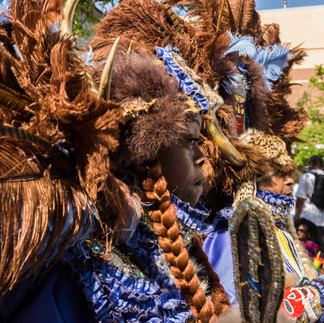Are you looking for a heavy dose of New Orleans Culture? Then, we've got you covered.

Carnival (known to some as Mardi Gras Season) almost always runs across February, which is also Black History Month. So it's easy to get wrapped up in the partying, the costuming, luncheons, etc.
But if we focus on that alone, we miss a significant opportunity to appreciate black history and culture here in New Orleans. All it takes to get started is to pause, be present, and look around.
The ladies of Team Cool Murphy offer you four opportunities to do just that. Below you'll find the stories of the Mardi Gras Indians, the Northside Skull and Bones Gang, St Augustine Catholic Church, and the Treme Sidewalk Steppers.

Mardi Gras Indians
Talented REALTOR and internationally renowned photographer Jess Rocco excels at recording moments frozen in time across her subject's faces. Her portrait work is phenomenal, and some of her favorite work features the Mardi Gras Indians.
Here are her words and work.
"If finding the Indians isn't on your Mardi Gras list this year, I'd highly recommend it! They never published their parade routes/times in advance - that's part of the Mardi Gras magic when you do happen upon them.
If you're not familiar with the background of the Mardi Gras Indians, keep reading:
The history of Mardi Gras Indians in New Orleans is rooted in African American communities and dates back to the late 1800s. These communities formed their own "tribes" to celebrate Mardi Gras and engage in traditional African American songs and dances. Over time, the tradition evolved to include elaborate and colorful costumes made from beadwork and feathers, often depicting themes and symbols inspired by Native American cultures.
In the early years, the Mardi Gras Indian traditions were often marred by conflict, with rival tribes clashing in the streets. This resulted in confrontations that sometimes turned violent, leading to injuries and even deaths.
It wasn't until the mid-20th century that a turning point was reached, with leaders such as Tootie Montana working to promote peace and unity among the various tribes. He also helped to revive interest in the tradition and bring recognition to the Mardi Gras Indians, both within New Orleans and beyond. Through these efforts, the violence gradually subsided. Today, the Mardi Gras Indians are widely celebrated for their elaborate costumes and vibrant parades, so definitely don't miss out on this tradition!"
The song Iko Iko, made famous by The Dixie Cups, includes lyrics like
"My flag boy and your flag boy
Sittin' by the fire
My flag boy told your flag boy
"I'm gonna set your flag on fire,"
describes the Mardi Gras Indians.
Some of Jess's portrait work, including those of the Mardi Gras Indians, hang on the walls of the set of the popular New Orleans show Mayfair Witches. The show also featured Sara's favorite krewe, The Northside Skull and Bones Gang.

The Northside Skull and Bones Gang
A talented reader and researcher - with two master's degrees - Sara Skjerli enjoys diving deep into anthropology. Her work here has given her deep respect and admiration for the Northside Skull and Bones Gang.
These are her words.
"For more than 200 Fat Tuesday mornings, The North Side Skull and Bone Gang have gone door to door, waking up the residents of the Treme neighborhood. Always with a message to live right and to remind people that we are mortal…, live a moral life, and avoid becoming skulls and bones.
Their traditional Fat Tuesday wake-up call is rooted in African and Creole traditions, with Chief Bruce 'Sunpie' Barnes leading the way. Chanting, "If you don't live right, the Bone Man is common' for ya'" to beating drums and tambourines, the group makes their way through the historic Treme.
Traditionally, big white heads made from wire and cheesecloth, skeletons, and actual bloody bones were used as a stern reminder to be good and remember the fragility of life.
Today, the group's focus is not just to scare the morality into people but to encourage us all to "eat, drink, and be merry… for tomorrow we all may die".
A 2017 short film called Skull + Bone gives a great six-minute glimpse into the history and importance of continuing this culture-bearing tradition.
If you're interested in taking this journey and celebrating 'just another Tuesday' with the North Side Skull and Bones Gang, they leave at 5 am on Mardi Gras Day from the Backstreet Cultural Museum at 1116 Henriette Delille Street, NOLA across from St Augustine Catholic Church.
Photographs courtesy of @northsideskullandbonegang on Facebook

St Augustine Catholic Church
A cradle Catholic, Elisa "fell away" in college. But she found her faith again after finding St Augustine Catholic Church. She now sings in the Saint Augustine Soulful Voices Choir and joined the church's restoration board in 2018.
While serving on the board, Elisa headed up media relations and unearthed and shared with all who would listen to the church's unique history.
These are her words.
"Saint Augustine Catholic Church has stood as a testament to faith, love, and inclusion for almost 200 years and is in danger of being lost.
Established in 1841, Saint Augustine Catholic Church was built to provide a place of worship to a diverse population of people who identified as Free People of Color, Whites, Slaves, and Creoles. Over time it has become the soul of New Orleans's Treme.
According to the National Museum of African American History and Culture, Saint Augustine is the oldest Catholic church to serve the black community in the United States. It has continually stood as a testament to faith, love, and inclusion for all people for over more than 180 years. The Venerable Henriette DeLille, Homer Plessy, Lolis Elie, "Chief of Chiefs" Allison "Tootie Montana are just some parishioners who have drawn spiritual strength from worshipping here.
When people talk about the birth of jazz, they talk about St Augustine; they don't know that they are. The story goes that jazz was created by New Orleanians who would gather each Sunday; after mass naturally. Church doors would open, and the parishioners would head down to Congo Square to enjoy their day off.
The marriage of church sounds and instruments and those honoring the musicians' African ancestors created the unique vocal aspects of jazz, like call and response. The nearest and first church in Back-A-Town, New Orleans? St Augustine.
Today St Augustine remains the soul of America's Oldest Black neighborhood. It's the home of Treme's Fall Festival, the home of Satchmo Jazz Mass, and the host of many less formal occasions, including second lines, events, and community outreach. It is also home to the Tomb of the Unknown Slave. The tomb is a cross made of heavy iron chains and serves as a shrine honoring all unknown slaves across the entire United States."
So when you're looking to teach or pay respects to the lives of those forever changed by our country's history of enslavement, visit the church at the corner of Henriette Delille and Treme Streets.
And when you're listening to that Mardi Gras playlist or any New Orleans-based music for that matter, know that its roots likely come from Treme, and its magic includes some of the soul of St Augustine Catholic Church.
For more information on the history of St Augustine Catholic Church and how you can get involved in saving this historic sacred place, visit https://staugchurch.org/
All images above are from the church's restoration collection.

The Treme Sidewalk Steppers
Brittany hails from a background in live theatre. A dancer, she goes wherever her heart and feet take her. And her feet often take her to Treme. Her newfound love? The Treme Sidewalk Steppers.
These are her words.
"The Sidewalk steppers from the 6th ward, also known as the Treme, are famous for their annual Second line parade. They put on a show like no other and are impeccably dressed while doing so. To understand what these social aid and pleasure clubs mean to the community, you have to first understand the history.
In the early 1800s, the Treme neighborhood became home to many free people of color. It is also where some of the richest creole architecture can still be found. The Treme residents began to design a community in their image, stemming from all of the different cultural backgrounds. As we can see today, this proved to be the best decision and has stood the test of time for generations.
Black mutual societies were originally founded to help the black and creole people of the community as public services were scarce. This became a huge support system. Health care was provided, funerals were sponsored, and the true meaning of "helping thy neighbor" was practiced.
Treme residents worked hard for themselves and their societies. Most worked 6 days a week, and instead of resting on the 7th day, the community chose to come together to celebrate life and culture. They'd decided long ago that ceremonies weren't only meant to bury the dead and bring the spirit to life. Residents did this by creating music and dancing in the streets. As a dancer, I believe that expression is crucial, and the creativity displayed on Second Line Sundays is the epitome of that.
As the years have progressed, the social aid and pleasure clubs have evolved into their own entities, like many things here in the City of New Orleans. The locals took "Sunday's best" to new heights by adding accessories and coordination. In the beginning, the community came out by the hundreds, and today they come by the thousands from far and wide to see pleasure clubs like the Sidewalk Steppers put on one of the greatest performances you'll ever witness. Watching the young and old transform to the sound of the brass bands. Foot working from the bottom to the top and by top I mean rooftops, literally. This Treme holiday is one of my favorite days of the year and I look forward to many more. Everyone should do themselves a favor one year and rooolllllll with it!"
For more information on the Treme Sidewalk Steppers, to learn about where they'll be, and to witness their incredible craft, follow them on Instagram @sidewalksteppers. All photos shown are reposted here from @sidewalksteppers IG account.
So there you have it, four incredibly important, wholly New Orleans bastions of culture. What will you look around, see, and pay respects to this Black History Month in New Orleans?

Voted Neighborhood Favorite by Nextdoor, Team Cool Murphy is a top-producing, licensed real estate team based in New Orleans, brokered by Cool Murphy LLC.
Reach out to us; we'd love to help you love where you live in New Orleans.
Contact Us -
email: cool@coolmurphy.com
Facebook: @homeinneworleans
IG: @coolmurphynola
Youtube: @coolmurphynola
phone: 504-321-3194














































Comments